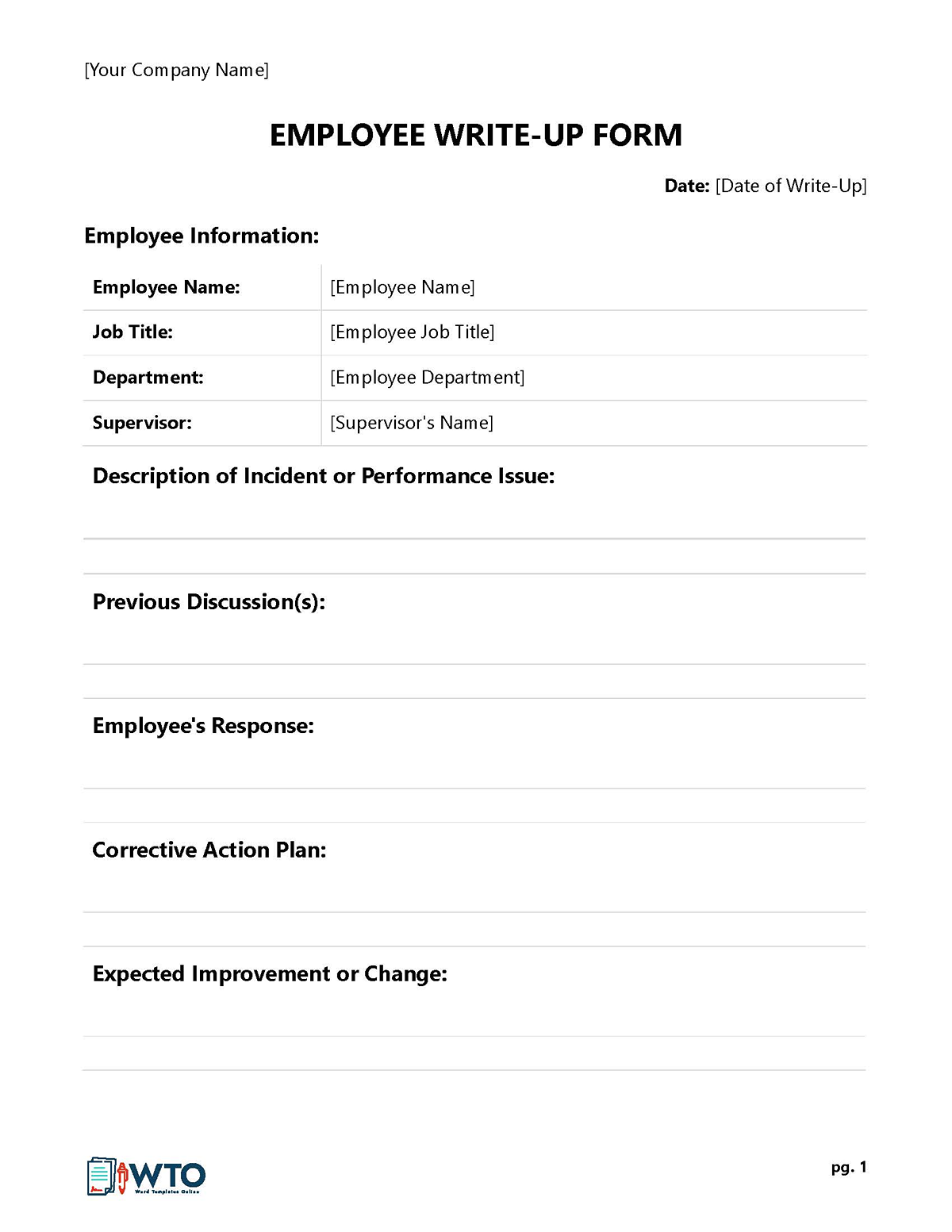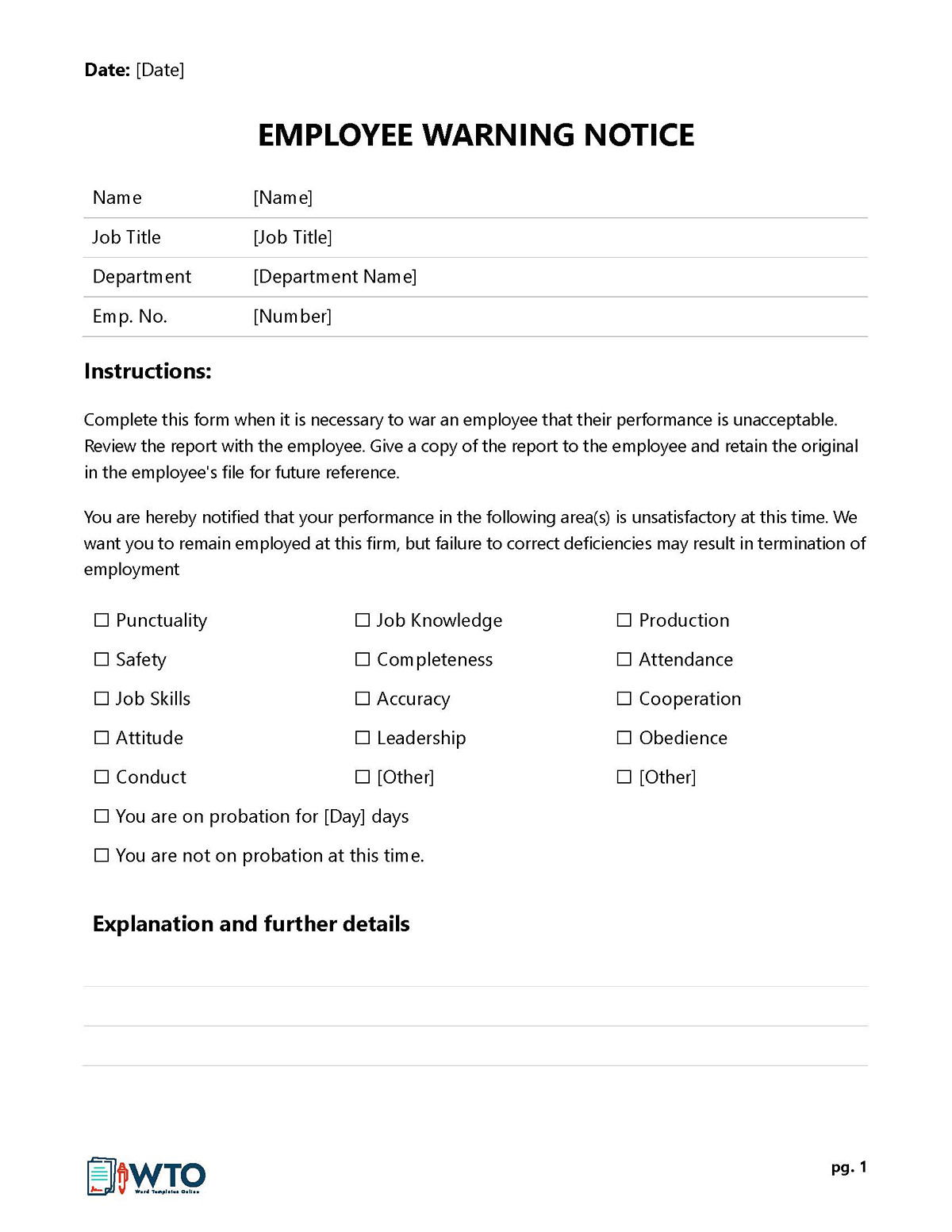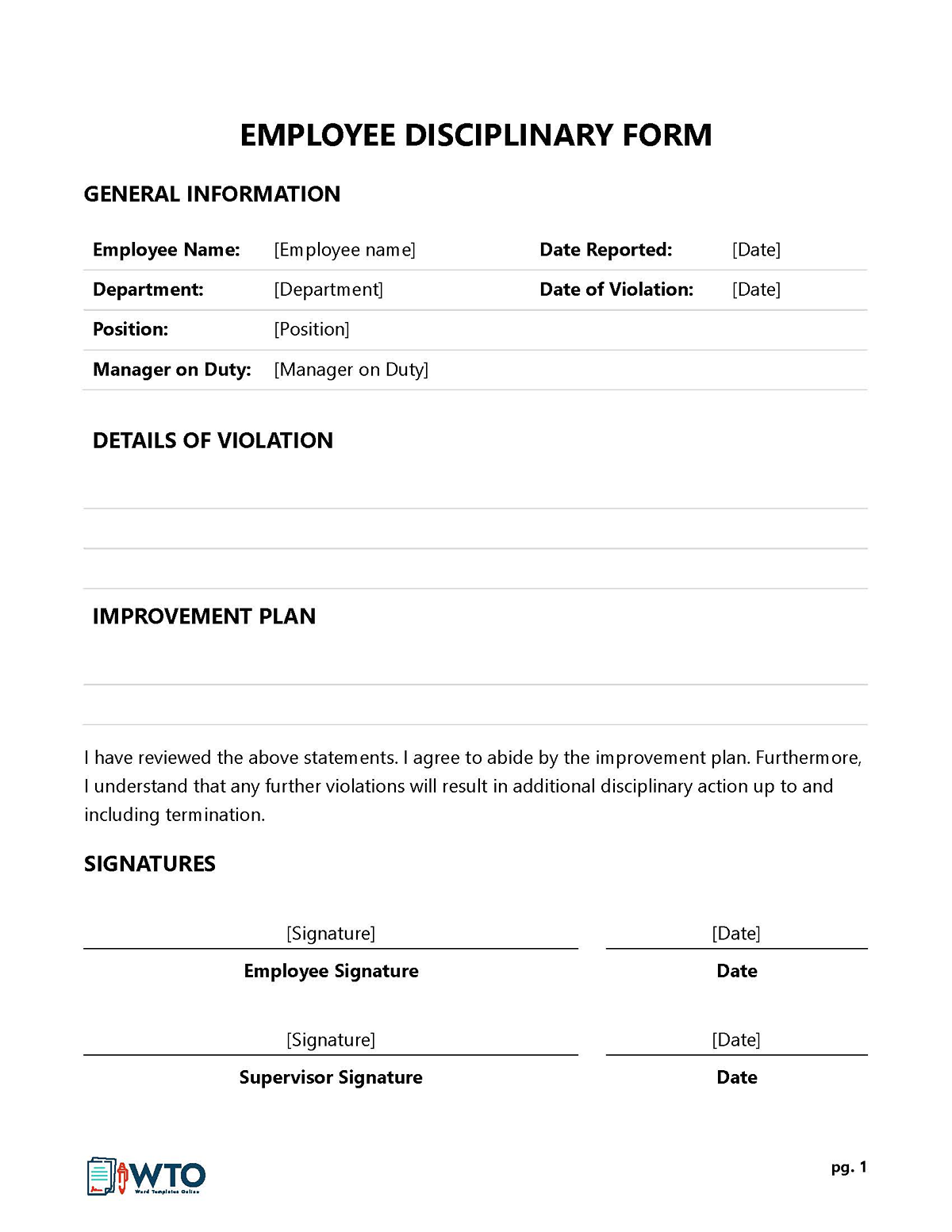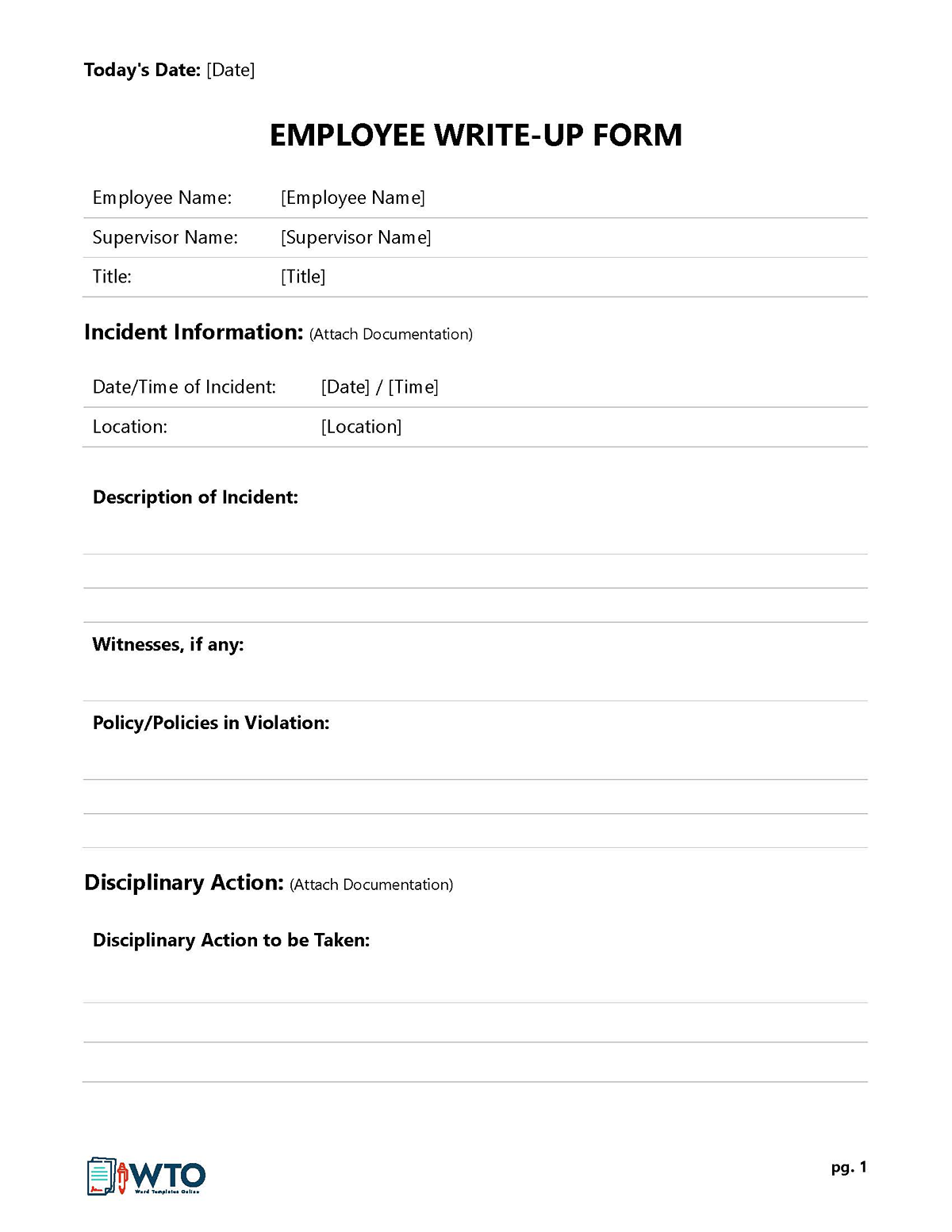An employee write-up form is an employee disciplinary report that documents formal feedback on an issue, usually by a supervisor in the workplace.
Employee write-ups are typically used to document incidents of lateness, absences, and failed performance reviews. Depending on the severity level, employee write-ups can serve as formal discussions regarding the issue or warning before termination.
The write-up process enhances the overall effectiveness of an organization. Employee write-up forms are used to ensure that proper documentation of workplace actions is maintained. These forms allow employers to maintain a record of an employee’s involvement with the company and provide added protection against claims that may be filed by the employee challenging his or her dismissal.
An employee write-up form is rarely the first intervention but rather a subsequent action after failed informal interventions and basic written warnings. Also, write-ups will often be issued after multiple incidents of consistent misbehavior or poor performance.
A well-structured employee write-up form should help highlight the employee’s behavior, supervisor’s feedback, improvement plans, goals, and consequences of lack of improvement. Employee write-ups can be vital in disputes resulting in eventual termination as they show what took place, when, and why termination was a justified course of action. This way, former employees cannot claim wrongful termination.
If you’re having trouble getting some employees to follow basic workplace rules, this article will guide you on using an employee write-up form and what to include when writing one.
How to Use it?
An employee write-up form is a document detailing the problems and concerns about a particular employee. It is often sent at the end of an investigation, a series of events or after warnings being sent and when disciplinary actions have failed to produce the expected results. The write-up form should detail what happened, when it happened, why it happened, who witnessed it happening, and offer the employee a chance to provide his or her point of view.
Below is a thorough description of the process of utilizing an employee write-up form:
Step 1: Document the problem
The first step in using an employee write-up form is to document the problem and any ensuing concerns. The form will serve as record of what transpired and where, as well as indicate why it happened. Ensure to capture the facts such as dates, timeframes, etc., as accurately as possible.
Also, when writing your employee write-up form, make sure to include the types of disciplinary actions taken prior to writing, like verbal warnings or written reprimands. You can also reference any company policies the employee has violated. Clarify the probable consequences should the employee fail to make amends.
Step 2: Share the document privately
Next, you should hold a private meeting with the employee and notify them of the write-up form. This gives them an opportunity to review the document and realize the severity of their actions.
Step 3: Read each part of the form to the employee
During the meeting, go through each concern raised in the form. You should go through the document with the employee rather than handing them the document to read. Provide examples of when the employee demonstrated poor performance, bad behavior, or violated company policies. You can also illustrate the discrepancy between what was done and what was expected. You can invite a witness to attest to the meeting. Then, inform them of what will happen going forward, whether there will be an improvement plan in place or the employee is expected to take corrective actions for their own violation.
You must ensure that you take note of any agreements so that the violating party can be held accountable for their promises. If these promises were made verbally, make sure they are documented in writing before releasing the employee.
Once a resolution is reached, you must document the outcome of the discussion in an employee write-up form. The company should then follow up to ensure that any improvement plans have been implemented and monitored.
Step 4: Have the employee sign the form
Next, provide the employee with the write-up form and have them sign it. By signing the document, the employee attests to the document’s contents. If the employee doesn’t agree with the claims, they can always refuse to sign the document, and you aren’t allowed to coerce or force them to do so. If this is the case, then alternative options should be opted for in order to tackle the issue.
Step 5: Allow for a response
Give them a chance to consider the stated facts, explain their side of the story, admit to any of the written down events, discuss how they are going to improve their performance and oppose any actions they don’t agree to. They can write their response, which can also be attached to the employee write-up form. You can impose a deadline for their response to avoid a situation where the employee doesn’t want to agree to the claims yet continues to display unacceptable behavior.
Employee Write-Up Form Templates
Employer write-up forms are very detailed documents that take a considerable amount of time and care to be completed smoothly and professionally. However, templates can be used to alleviate this burden. Templates entail the essential sections of a well-written, and well-structured employee write-up to be filled by the user. This speeds up the writing process and ensures supervisors and managers capture all the relevant details. You can download such templates from our site for free and customize them to make professional and consistent write-up forms for your organizations.




What to Include in an Employee Write-Up Form
To effectively make an employee write-up form, there are a few key things to focus on. When preparing it, the most significant thing to remember is to write clearly and make it easy for the reader to understand. An employee write-up form should be written to describe the issue at hand and be addressed to an individual employee. It is also advised to provide or utilize a copy of the company’s policy or rules based on the matter in question. The form should also provide a space for the employee’s response (if applicable) and details on any potential oral or written warnings given before this final form, depending on the scenario.
Essential components included in an employee write-up form include:
Employee information
This will contain the employee’s name, contact information, and the date of any prior problematic events. It should also include their job title, name of the supervisor, department, and any identifying information.
Type of offense
The write-up form should indicate the specific type of offense the employee committed or has undertaken. For example: “verbally abusing co-workers.” Other examples of offenses include consistent tardiness and absenteeism, poor quality/quantity of work, breach of safety protocols, inappropriate dressing, sexual harassment, physical abuse, complaints from co-workers and clients, substance abuse, etc.
Description of the incident
The description of the infraction should be detailed to show exactly what it is your employee has done wrong. The write-up form should also detail any witnesses, timeframes, dates, and relevant details regarding the incident(s). This information should be relayed in a narrative form. Ensure that you capture the exact details of all the events in question through the wording used. This way, you can list them on a timeline and see how long the employee has been repeatedly making violations.
Past disciplinary action
If there have been prior oral or written warnings, they should be documented in the employee write-up form along with the reason why they were issued. These might be present in the form of previous written warnings, oral reprimands, and documented counseling. This will help show why the employee has been in violation.
A good example of such a scenario is when an employee who feels that he is unfairly targeted by the supervisors or colleagues who reported his or her actions that led to the warnings. When writing up the form, you can consider this and include details on any prior warning history, when they were issued, and what they ensued.
Relevant witness statements
Although you may not have supporting evidence of the events occurring, especially if third parties raised the concerns, you must take the time to obtain witness statements. If the write-up form has multiple witnesses in support of its claims, that is a strong point in making a detailed case against the employee. The witness statements should be relevant to the case at hand and be based on factual observations, not subjective opinions. Any interventions made (if any) by other supervisors and co-workers to remedy the behaviour should also be included in the statement.
Improvement plan
If the employee is issued a final warning rather than being fired, you should include a section for an improvement plan. This will provide the employee with guidelines on what needs to change in order for them to maintain their performance and retain the job. The improvement plan should be relevant to the infractions made by the employee, not the employee as a person, and should be clear in terms of what they are required to do immediately and in the future. An improvement plan serves as your corrective feedback to the employee and should have achievable goals.
Consequences
If the employee fails to honor the improvement plan or breaches any company policy again, they should be made aware that they risk being terminated or any other consequence. Ensure the consequences of their actions are fairly outlined in the write-up form and are not too lenient, unless there are valid reasons for them being so.
Completed by
The employee write-up form should then indicate the author. This will typically be the manager, supervisor, or any other entrusted party. This section should highlight the name, title, and the date on which it was written.
Employee statement regarding facts of the incident
An employee should be given a chance to issue a written explanation agreeing to, or opposing the claims of the write-up form. This explanation can be written down in the same form or on a separate document that is attached to it.
Employee acknowledgment
Employees have to acknowledge that they have read the write-up form, have had the time to respond to it, and have agreed or disagreed with it. The form cannot be completed until they acknowledge it. The employee should supply their name, signature, and date of signing. This should also include the signatures of any witnesses who are involved in the preparation of the write-up form.
Best Practices
A well-written employee write-up form should comprehensively address the employee’s violations, provide accurate documentation of them and offer a way forward. To ensure this is achieved, you can implement the following practices when preparing the document:
Be objective
The form should be written in an objective tone without opinion or bias. This will help the document gain credibility while also allowing you to use it as evidence later on. So, avoid preparing the document while you are angry. Instead, you can give yourself some time to calm down and write an unbiased write-up form.
Use company policies to explain your reasoning
If there is also a violated policy involved in the action being taken with the write-up form, then you can use that policy as supporting evidence. The policy can be used to detail why some actions of the employee were inapproproiate. Employees typically have to sign employment contracts when getting hired and from then vow to abide by their employer’s policies; therefore, violating these policies can form concrete grounds for neglecting them or displaying unacceptable behavior.
Keep a copy for record
When you are done writing up the employee and sending it to them, you should retain a copy for record-keeping purposes. This is especially important for protecting the company against any future claims from the employee.
Be thorough
To ensure that you’ve all the bases covered, you can write as much information as possible. Don’t simply state the infraction but also indicate the reasons given for them by the employee, date of the incidents, times, etc. This information will allow you to construct a strong case against the employee.
Keep it simple and direct
Keep the write-up simple and direct. The simplified and straightforward explanation can also help bolster your case in front of any legal counsel that is involved during a dispute later on. Also, include relevant details only. Avoid including personal opinions, slang, assumptions, or any language that indicates bias or emotional accounts. Also, do not use adjectives such as lazy, incompetent, or any other such words that label the employee unprofessionally.
Frequently Asked Questions
The primary benefit of the write-up form is that it allows you to discipline the employee but also gives them an opportunity to issue a response. If they have an explanation or they agree with your claims, they should mention that in their statement. Mostly, employees find these forms useful because it provides them with a way to explain themselves. They can give you any evidence to support their claims and also, in some cases, suppress other claims that you may have made against them.
Yes. Ordinarily, you are expected to issue a verbal warning before resorting to a write-up.
Common reasons for writing up an employee include, but are not limited to:
-Missing work
-Poor attitude
-Assault
-Physical, sexual, and verbal abuse
-Violating company policies
-Lying about material facts, e.g., workplace harassment or violence
-Stealing company property




